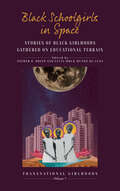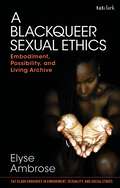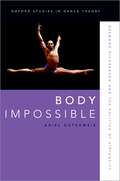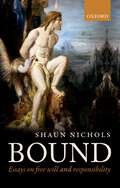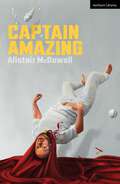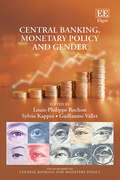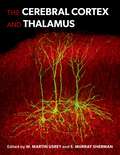- Table View
- List View
Black Schoolgirls in Space: Stories of Black Girlhoods Gathered on Educational Terrain (Transnational Girlhoods #7)
by Esther O. Ohito Lucía Mock Muñoz De LunaLocating Black girls’ desires, needs, knowledge bases, and lived experiences in relation to their social identities has become increasingly important in the study of transnational girlhoods. Black Schoolgirls in Space pushes this discourse even further by exploring how Black girls negotiate and navigate borders of blackness, gender, and girlhood in educational spaces. The contributors of this collected volume highlight Black girls as actors and agents of not only girlhood but also the larger, transnational educational worlds in which their girlhoods are contained.
A Blackqueer Sexual Ethics: Embodiment, Possibility, and Living Archive (T&T Clark Enquiries in Embodiment, Sexuality, and Social Ethics)
by Professor Elyse AmbroseIn A Blackqueer Sexual Ethics: Embodiment, Possibility, and Living Archive Elyse Ambrose looks to an archive of blackqueerness as an authoritative source for religious ethical reflection. This approach counters the disintegrative norms of anti-black and anti-body traditionalism in Christian sexual ethics, even those that strive to be liberative. It builds upon a tradition of black queer and LGBTQ+-centered critique at the intersections of race, sexuality, gender, and religion through exploring the moral imagination of sexual and gender non-conformist communities in 1920's Harlem (their rent parties, blues environments, and Hamilton Lodge Ball); ethics and theology blackqueering the disciplines; and contemporary oral histories (including photographs of the subjects by the scholar-artist) of those doing ethics in their blackqueerness. These serve as integrative sites that signal blackqueer ethical counter-patterns of communal belonging, individual and collective becoming, goodness, embodied spirit/inspirited bodies, and shared thriving. Emphases on both personal and social right-relatedness mark a shift from Christian sexual ethics based on rules, toward a communal relations-based transreligious ethics of sexuality.
The Bloomsbury Handbook of Language Learning and Technology (Bloomsbury Handbooks)
This handbook draws together international perspectives on technology and its application to language teaching and learning, written and edited by leading scholars in the field. It meets the increasing demand for pedagogically-informed online language instruction, which is particularly important in the context of the effects that the Covid-19 pandemic has had on the education sector on a global scale, as well as exploring language learning in informal and non-formal contexts. With contributions from5 continents and over 20 countries, including Australia, Canada, Cyprus, Denmark, Finland, France, Greece, Ireland, Japan, Spain, Sweden, the Netherlands, the UK and the USA, the book offers a thorough overview of the main influential theories and explores technology tools, approaches to research, and applications to practice. Carefully curated, this is an innovative and exciting volume for students, teachers, researchers and lecturers in language education.
The Bloomsbury Handbook of Linguistic Landscapes (Bloomsbury Handbooks)
Presenting a detailed examination of the origins, evolutions, and state-of-the-art of linguistic landscape research, The Bloomsbury Handbook of Linguistic Landscapes is a comprehensive guide to the burgeoning field of linguistic landscapes and the study of meaning and interpretation in public spaces and settings. Providing a thorough synopsis of the theories, methodologies, and objects of study which inflect linguistic landscape research across the world, this book is the ideal companion for both new and experienced readers interested in the processes of communication in public spaces across diverse settings and from a broad range of perspectives. Through a wide selection of case studies and original research, the handbook highlights the global reach of linguistic landscape theories and practices. Scrutinising an array of qualitative, quantitative, and mixed methodological approaches for analysing a wide spectrum of meaning-making phenomena, it investigates semiosis in contexts ranging from graffiti and street signs to tattoos and literature, visible across a variety of sites, including city centres, rural settings, schools, protest marches, museums, war-torn landscapes, and the internet.
The Bloomsbury Handbook of Modernist Archives (Bloomsbury Handbooks)
Providing a broad, definitive account of how the 'archival turn' in humanities scholarship has shaped modernist studies, this book also functions as an ongoing 'practitioner's toolkit' (including useful bibliographical resources) and a guide to avenues for future work. Archival work in modernist studies has revolutionised the discipline in the past two decades, fuelled by innovative and ambitious scholarly editing projects and a growing interest in fresh types of archival sources and evidence that can re-contextualise modernist writing. Several theoretical trends have prompted this development, including the focus on compositional process within genetic manuscript studies, the emphasis on book history, little magazines, and wider publishing contexts, and the emphasis on new material evidence and global and 'non-canonical' authors and networks within the 'New Modernist Studies'. This book provides a guide to the variety of new archival research that will point to fresh avenues and connect the methodologies and resources being developed across modernist studies. Offering a variety of single-author case studies on recent archival developments and editing projects, including Samuel Beckett, Hart Crane, H.D., James Joyce, Dorothy Richardson, May Sinclair and Virginia Woolf, it also offers a range of thematic essays that examine an array of underused sources as well as the challenges facing archival researchers of modernism
The Bloomsbury Handbook of Religion, Gender and Sexuality (Bloomsbury Handbooks)
Bringing together disciplines across the arts, humanities and social sciences, this Handbook presents novel and lively examinations of the dynamic ways religion, gender and sexuality operate. Applying feminist, intersectional, and reflexive approaches, the volume aims to loosen imperialist and exclusionary figurations that have underwritten and tethered religion, gender, and sexuality together. While holding onto the field of inquiry, the Handbook offers contributions that interrogate and untie it from the terms and conditions that have formed it. The volume is organized into thematic sections: - Forces and Futures- Activisms and Labors- Agencies and Practices- Relationships and Institutions- Texts and Objects Chapters range across religious, geographical, historical, political, and social contexts and feature an array of case-studies, experiences, and topics that exemplify the reflexive intention of the volume, including explorations of race, whiteness, colonialism, and the institutional intolerance of minority groups. Contributors also advance new areas of research in religion including artificial intelligence, farming, migrant mothering, child sexual abuse, mediatization, national security, legal frameworks, addiction and recovery, decolonial hermeneutics, creative arts, sport, sexual practices, and academic friendship. This is an essential contribution to the fields of religious studies and gender and sexuality studies.
Bloomsbury Teacher Guide: A comprehensive guide to teaching Meera Syal's GCSE set text (Bloomsbury Teacher Guides)
by Zara Shah Kerry KurczijBloomsbury Teacher Guide: Anita and Me weaves together the essential subject knowledge, ready-to-use resources and classroom strategies needed to teach Meera Syal's extraordinary story, as well as fresh ideas to teach this GCSE set text that are as exciting for you as they are for your students.Each chapter contains suggested schemes of work and lesson ideas to enhance subject knowledge on key areas of the text, with focus on historical and cultural context, understanding the plot, character analysis, key themes and detailed analysis of language, form and structure, appropriate for all GCSE exam boards and for pre-teaching at KS3 level. Effective and engaging strategies are included for relevant lessons and exam preparation, from retrieval practice to scaffolding and reciprocal reading. The book includes exclusive downloadable and printable teaching resources for instant use in the classroom to support students at all levels.Whether you are new to teaching or looking for varied ideas to try out in the classroom, this Bloomsbury Teacher Guide will be your expert companion to the study of the Anita and Me.
Body Impossible: Desmond Richardson and the Politics of Virtuosity (Oxford Studies in Dance Theory)
by Ariel OsterweisBody Impossible theorizes the concept of virtuosity in contemporary dance and performance through a study of the career of dancer Desmond Richardson. A virtuoso for the ages, Richardson is renowned for delivering commanding performances over decades in contexts ranging from the stages of the Alvin Ailey American Dance Theater and Ballett Frankfurt to featured appearances with Michael Jackson and Prince, along with his work as co-founder of Complexions Contemporary Ballet, inaugurating a virtuosic queer black aesthetic with choreographer Dwight Rhoden. Focusing on Richardson's creative insistence on improvisatory fun and excellence throughout the decades approaching the millennium (shaped by Reaganism, the Culture Wars, the AIDS epidemic, the New Jim Crow, and MTV), this book brings dance into conversation with paradigms of blackness, queerness, masculinity, and class in order to generate a socioculturally attentive understanding of virtuosity. Virtuosity obscures the border between popular and concert performance, and Richardson's versatility epitomizes the demands on the contemporary virtuosic dance artist. Author Ariel Osterweis suggests that discourses of virtuosity are linked to connotations of excess, and that an examination of the formal and socio-cultural aspects of virtuosic performance reveals under-recognized heterogeneity in which we detect ?vernacular? influences on ?high art.? In doing so, Body Impossible accounts for the constitutive relationship between disciplined perceptions of virtuosity's excess and the disciplining of the racialized body in national and transnational contexts.
Bound: Essays on free will and responsibility
by Shaun NicholsThe problem of free will arises from ordinary, commonsense reflection. Shaun Nichols examines these ordinary attitudes from a naturalistic perspective. He offers a psychological account of the origins of the problem of free will. According to his account the problem arises because of two naturally emerging ways of thinking about ourselves and the world, one of which makes determinism plausible while the other makes determinism implausible. Although contemporary cognitive science does not settle whether choices are determined, Nichols argues that our belief in indeterminist choice is grounded in faulty inference and should be regarded as unjustified. However, even if our belief in indeterminist choice is false, it's a further substantive question whether that means that free will doesn't exist. Nichols argues that, because of the flexibility of reference, there is no single answer to whether free will exists. In some contexts, it will be true to say 'free will exists'; in other contexts, it will be false to say that. With this substantive background in place, Bound promotes a pragmatic approach to prescriptive issues. In some contexts, the prevailing practical considerations suggest that we should deny the existence of free will and moral responsibility; in other contexts the practical considerations suggest that we should affirm free will and moral responsibility. This allows for the possibility that in some contexts, it is morally apt to exact retributive punishment; in other contexts, it can be apt to take up the exonerating attitude of hard incompatibilism.
Brain Science for Lawyers, Judges, and Policymakers
by Morris B. Hoffman Francis X. Shen Owen D. Jones Jeffrey D. Schall Anthony D. WagnerBrain science in the form of neuroscientific evidence now appears frequently in courtrooms and policy discussions alike. Many legal issues are at stake, such as how to separate the best uses of brain science information from those that are potentially biasing or misleading. It is crucial to evaluate brain science evidence in light of relevant legal standards (such as the Daubert and Frye Rules). Brain Science for Lawyers, Judges, and Policymakers responds to this rapidly changing legal landscape, providing a user-friendly introduction to the fundamentals of neuroscience for lawyers, advocates, judges, legal academics, and policymakers. It features detailed but clear illustrations, as well as a comprehensive and accessible overview of developments in legally relevant neuroscience. Readers will learn brain science terms, how to understand and discuss brain structure and function in legally relevant contexts, and how to avoid over- or under-interpreting neuroscientific evidence. The book begins with a survey of the kinds of litigation, legislation, and regulation where neuroscience is currently being used. It provides accessible descriptions of basic brain anatomy and brain function as well as an overview of how modern technologies can reveal the brain structures and brain functions of individuals. It finishes with cautions and limitations, including timely and thought-provoking observations about where the future of neurolaw might lead. Throughout, the authors offer clear and concise guidance on understanding both the promise and the limitations of using brain science in law and policymaking.
Breaking the Dead Silence: Engaging with the Legacies of Empire and Slave-Ownership in Bath and Bristol’s Memoryscapes (Liverpool Studies in International Slavery #22)
An Open Access edition will be available on publication. The murder of George Floyd in 2020, the renewed international take up of the cry Black Lives Matter and the subsequent toppling of a statue commemorating slave-merchant-turned-philanthropist Edward Colston in Bristol provoked urgent questions on memorialisation, white privilege, social justice and repair. Debates on how legacies of colonialism and empire in Britain should be addressed spilled out of the scholarly world into the public discourse. In the immediate wake of the statue toppling this book offers a unique, distinctive and timely contribution to those debates: a series of voices and experiences are offered as critical commentaries and accounts of recent interventions on an official heritage narrative. It sets out to break the ‘dead silence’, by bringing together diverse perspectives from academics, artists, activists, heritage professionals and tourist guides. The book offers fresh insights, referencing work attending to the impacts and legacies of colonisation primarily in Bath and Bristol, augmented with comparative contributions from Lancaster and Mexico offering significant and pertinent resonances. A range of strategies are explored towards enabling silenced voices to be heard and engage in conversations about how the past is represented, including Co-Creation, new agonistic museum practices, innovative creative and somatic approaches.
A Brief History of the Philosophy of Time
by Adrian BardonThis thoroughly revised and updated edition of Adrian Bardon's A Brief History of the Philosophy of Time is a short introduction to the history, philosophy, and science of the study of time--from the pre-Socratic philosophers through Einstein and beyond. Bardon covers subjects such as time and change, the experience of time, physical and metaphysical approaches to the nature of time, the direction of time, time travel, time and freedom of the will, and scientific and philosophical approaches to cosmology and the beginning of time. He employs helpful illustrations and keeps technical language to a minimum in bringing the resources of over 2500 years of philosophy and science to bear on some of humanity's most fundamental and enduring questions.
Briefly Very Beautiful
by Roz DineenA startlingly beautiful story of a family's survival, and an unforgettable dystopian vision of a familiar world in flames'Impossible to put down' Daily Telegraph'Instantly immersive, beautifully imagined, this is an unflinching but inspiring story about some things we're going to lose, and other things we must never lose' Lee Child'Left me breathless: it is a stunning, poetic, impelling story of love and survival, which I could not stop reading ... An incredible novel' Jodie Whittaker______________________________________The world is on fire. And what will you do?In a city rocked by global catastrophe, home-grown terrorism, shortages and wildfires, Cass is quietly raising three small children by herself. Her husband, Nathaniel, has left to serve as a medic in a war overseas.As life in the city becomes increasingly impossible, Cass knows she can no longer wait for Nathaniel's return. Packing up their lives, she and the children set off in search of a place of greater safety.But Cass will learn that not all promises and not all sanctuaries are what they seem – and as the fires around them begin to close in, she'll discover just how far she'll go for her children in a world teetering on apocalypse.Sensual, claustrophobic and vivid, Briefly Very Beautiful announces the arrival of a major new talent, painting an unforgettable portrait of a mother trying to hold her family together. ______________________________________________'Beautiful and timely, tough yet tender ...This is an important book and I devoured it' Clover Stroud'Gorgeous, fierce and haunting ... A book that is, quite literally, on fire. Very beautiful and all-too brief' Catherine Taylor 'A story that burns from the page. Dineen writes about motherhood and the climate crisis with piercing clarity' Amy Twigg, author of Spoilt Creatures'A haunting vision of our slow-motion apocalypse. This is exactly what it will be like' Michael LaPointe, author of The Creep
Bringing Krishna Back to India: Global and Local Networks in a Hare Krishna Temple in Mumbai
by Claire C. RobisonThe Hare Krishnas have long been associated with Western hippie culture and New Age religious movements, but they have also developed deeply rooted communities in India and throughout the world over the past 50 years. Known officially as the International Society for Krishna Consciousness (ISKCON), this once-marginal religious community now wields vast economic assets, political influence, and a posh identity endorsed by Indian business tycoons and Bollywood celebrities. Bringing Krishna Back to India examines the place of this globalized religious community in Mumbai, India's business and entertainment capital, where ISKCON draws Indians from diverse regional and religious backgrounds and devotees adopt a conservative religious identity amidst a neoliberal urban context. Claire C. Robison examines the full-circle globalization of this religious movement and considers how religious revivalism shifts people's relationships to their religion, family, culture, and nation. By inhabiting a Hindu revivalist role, ISKCON educates Hindus and Jains into a new vision of their own traditions and promotes greater religiosity in Indian public life. This contradicts notions that societies are moving towards secularism and highlights how new religious identities are fashioned amidst industrialized urban spaces, such as college campuses, corporate wellness retreats, and Bollywood celebrity events. It also shows how local religion is shaped by transnational networks-even forms of revivalism that revere premodern ideals. In urban India religious traditionalism is often a form of cosmopolitanism, partaking in neoliberal economies, shaping political trends, and reflecting elite urban aspirations and aesthetics.
Buddhism Between Religion and Philosophy: N?g?rjuna and the Ethics of Emptiness
by Rafal K. StepienN?g?rjuna (c. 150-250), founder of the Madhyamaka or Middle Way school of Buddhist philosophy and the most influential of all Buddhist thinkers aside from the Buddha himself, concludes his masterpiece, Fundamental Verses on the Middle Way, with these baffling verses: For the abandonment of all views He taught the true teaching By means of compassion I salute him, Gautama But how could anyone possibly abandon all views? In Buddhism between Religion and Philosophy, Rafal K. Stepien shows not only how N?g?rjuna's radical teaching of no-view or ?abelief? makes sense within his Buddhist philosophy, but also how it stands at the summit of his religious mission to care for all living beings. Rather than treating any one aspect of N?g?rjuna's ideas in isolation, here his metaphysics, epistemology, and ethics emerge as a single coherent and convincing philosophical-religious system of thought and practice. Grounded in meticulous study of original texts from classical India and China but innovating on the theories and methods underpinning contemporary scholarship East and West, this study shows how profoundly important voices from the diverse religious and philosophical traditions of the world have until now been diminished, distorted, and silenced. In opening up truly global horizons of existing and co-existing in the world, this work challenges the very ways in which we think about religion and philosophy.
Buddhism in Court: Religion, Law, and Jurisdiction in China
by Cuilan LiuWhat happens to Buddhist monks and nuns who commit crimes? Buddhism in Court is the first book to uncover an important, yet long-overlooked, Buddhist campaign for clerical legal privileges that aim to exempt monks and nuns from being tried and punished in the government courts. Liu reveals the campaign's origins in Indian Buddhism and how Chinese Buddhists' engagement reshaped Buddhism's place in the jurisdictional landscape in China from the fourth century to the present. Drawing on Buddhist monastic law texts, archives, court documents, Chinese laws, official histories, law case books, institutional announcements, and private writings circulated on social media, Buddhism in Court traces the legacy of the campaign for clerical legal privileges from its origin in India to its transformation in China and its continuing impact in the Chinese courtroom to the present day. Diverting from the dynasty-centered approach to studying religion, law, and history in China, Buddhism in Court expands our understanding of this legacy of early Chinese Buddhism and challenges the notion that the transition between imperial and post-imperial China was marked only by disruption.
Building a Social Science: 19th Century British Cooperative Thought (Oxford Studies in the History of Economics)
by Kirsten Madden Joseph PerskyJust as the Industrial Revolution in Britain suggested a promise of abundance, David Ricardo, Robert Malthus, and their colleagues formalized classical political economy with its emphasis on scarcity, self-interest, and private accumulation of capital. At the same time, Robert Owen took a different path arguing that the new technologies open a new world. In effect, his ideas turn classical political economy on its head. Building this new social science, Owen emphasizes abundance, public spiritedness, and communal accumulation of capital. Although the history of the cooperative movement is well documented, the social psychology, architecture, and logic of its economics stand in need of reappraisal. This book describes, often restates, and in places reconstructs the social science of British cooperative writers-from Robert Owen, through William Thompson and Anna Doyle Wheeler, J.S. Mill and Harriet Taylor Mill, the Christian Socialists, the consumer cooperative movement, the Women's Cooperative Guild, William Morris, and the Guild Socialists. Each of these writers makes theoretical assumptions concerning social psychology, proposes institutional structures, and then derives consequences for the material economy, happiness, and human development. Some postulate a feedback mechanism strengthening and stabilizing an enlarged self-interest. Sparked by the intellectual optimism and fellow feeling of the early British cooperative theorists, Madden and Persky start to rebuild their humane social science. While enriching our understanding of intellectual history, Building a Social Science carries insights relevant to the present concerning employment relations, persistent inequality, and low levels of human development.
Bulk Collection: Systematic Government Access to Private-Sector Data
This is an open access title available under the terms of a CC BY-NC-ND 4.0 International licence. It is free to read at Oxford Scholarship Online and offered as a free PDF download from OUP and selected open access locations. This book is the culmination of nearly six years of research initiated by Fred Cate and Jim Dempsey to examine national practices and laws regarding systematic government access to personal information held by private-sector companies. Leading an effort sponsored by The Privacy Projects, they commissioned a series of country reports, asking national experts to uncover what they could about government demands on telecommunications providers and other private-sector companies to disclose bulk information about their customers. Their initial research found disturbing indications of systematic access in countries around the world. These data collection programs, often undertaken in the name of national security, were cloaked in secrecy and largely immune from oversight, posing serious threats to personal privacy. After the Snowden leaks confirmed these initial findings, the project morphed into something more ambitious: an effort to explore what should be the rules for government access to private-sector data, and how companies should respond to government demands for access. This book contains twelve updated country reports plus eleven analytic chapters that present descriptive and normative frameworks for assessing national surveillance laws, survey evolving international law and human rights principles applicable to government surveillance, and describe oversight mechanisms. It also explores the concept of accountability and the role of encryption in shaping the surveillance debate. Cate and Dempsey conclude by offering recommendations for both governments and industry.
Can You Be a Catholic and a Feminist?
by Julie Hanlon RubioAn eminent theologian addresses an enduring--but newly urgent--question Is it possible to be both a faithful Catholic and an avowed feminist? Earlier generations of feminists first formulated answers to this question in the 1970s. Their views are still broadly held, but with increasing tentativeness and a growing sense of their inadequacy. Even now, Catholic women and men still say, "It's my Church and I'm not leaving," "Change will only happen if people like me stay and fight," and "The Church's work for social justice is more important than the issues that concern me as a feminist." Yet in a post-#MeToo, #ChurchToo moment, when the Church seems disconnected from struggles for racial justice and LGBTQ inclusion, those answers sound increasingly insufficient. Today, tensions between Catholicism and feminism are more visible and ties to Catholic communities are increasingly weak. Can Catholic feminism survive? Julie Hanlon Rubio argues that it can. But if it is going to do so, it is necessary to rethink how women and men who experience the pull of feminism and Catholicism can credibly claim both identities. In Can You Be a Catholic and a Feminist? Rubio argues that Catholic feminist identity is only tenable if we frankly acknowledge tensions between Catholicism and feminism, bring forward shared concerns, and embrace the future with ambiguity and creativity. Rubio explores the potential for synergy and dialogue between Catholics and feminists through various lenses, including sexual violence, gender theory, pregnancy and pre-natal loss, work-life balance, relationships and family life, spirituality, conscience, and what it means to be human. This book gives those who struggle to balance Catholicism and feminism a credible path to authentic belonging.
Captain Amazing (Modern Plays)
by Mr Alistair McDowallWhat do you do as Captain Amazing?Fight… baddies and things. Save people… make people go to bed when they're supposed to go to bed… Join the world's most unassuming superhero in Alistair McDowall's (Pomona, The Glow, X, all of it) critically-acclaimed masterpiece. From battling his arch-nemesis, to getting his daughter to school on time, follow Captain Amazing on his incredible adventures and discover how even the invincible aren't immune to tragedy.A hilarious and heart-breaking adventure which reminds us that one day, even the bravest of superheroes will need to hang up their cape… forever.This edition was published to coincide with the 10th anniversary production at London's Southwark Playhouse in May 2024.
Carthage (Archaeological Histories)
by Dr Sandra Bingham Dr Eve MacDonaldThis book traces the formation of the archaeological site of Carthage and how it re-emerged in the minds of European antiquarians and travellers in the early modern world. For almost 1,600 years the ancient city sat on the north coast of Africa, dominating the central Mediterranean until its fall in 698 CE. One of the oldest cities in the Mediterranean, it was founded in legend by the Tyrian queen Dido and destroyed after epic wars with Rome. It was soon reborn as a Roman city, and late in antiquity evolved into a centre for Christian worship. In the 17th and 18th centuries, when European explorers first arrived, searching for the site of Carthage, they were amazed that almost nothing of its former glory remained and lamented its loss. The gradual and sometimes controversial exploration of Carthage has, over the last two centuries, brought the story of this renowned ancient city back into the public imagination. From the first discovery of Punic artifacts to the plunder of the site for the enrichment of European museums, the book follows the many personalities whose interests and diligence led to the establishment of scientific archaeological excavations and the re-emergence of Carthage from the ruins.
Central Banking, Monetary Policy and Gender (The Elgar Series on Central Banking and Monetary Policy)
Central Banking, Monetary Policy and Gender uniquely explores the ways in which monetary policies, changes in interest rates and unconventional monetary strategies such as quantitative easing affect women. This groundbreaking book analyses the inner organisation of central banks, considering for the first time how banking transmission mechanisms operate in relation to gender, investigating issues of power, income, wealth inequality and labour market dynamics.Editors Louis-Philippe Rochon, Sylvio Kappes and Guillaume Vallet bring together internationally renowned scholars to present cutting-edge research. Chapters discuss the role of monetary policy in the gender pension gap; the impact of inflation reduction policies on female and male employment rates; the gender politics of comportment in central banking; the inner organisation of central banks and how financial crises can create systemic discrimination. Contributors advocate for looking beyond the traditional roles of central banks, encouraging scholars and practitioners to assess strategies and frameworks from alternative perspectives such as gender to highlight systemic inequalities and campaign for better, more equitable practices going forward.Offering a novel approach to central banking and monetary policy, this book will be invaluable to academics, students and researchers in political economy, feminist economics, and public policy. Its practical and timely guidance will also be of interest to professionals working in the banking, economic and financial sectors.
The Cerebral Cortex and Thalamus
For the first time, Drs. Usrey and Sherman, along with a who's who of luminaries in neuroscience research, seek to codify the roles that the cortex and thalamus and their interdependence on each other play for sensation, action, and cognition. The thalamus, in addition, has often been treated as a minor, rather insignificant player in cortical functioning. In the not too distant past, the thalamus was considered a rather boring, machine-like relay of subcortical information to the cortex. Over the past decade, there has been a groundswell of new and renewed interest in the thalamus and thalamocortical interactions, leading to discoveries demonstrating the thalamus's ongoing and essential role in cortical functioning and, likewise, the significance of the cortex for thalamic functioning. The Cerebral Cortex and Thalamus is a groundbreaking volume bringing together a cohesive account of cortical and thalamic mechanisms for control of behavior with an emphasis on the importance of interactions between the two structures. The book elucidates the research that makes it increasingly clear that the cortex and thalamus are necessary partners for sensory, motor, and cognitive functions. Interactions between thalamus and cortex are not only essential for proper brain function, they are also sensitive to a range of diseases that can have devastating consequences on individuals and society. An essential text for graduate students, early career investigators, and investigators looking to shift their research focus, The Cerebral Cortex and Thalamus is organized into topical sections covering circuit properties of thalamus and cortex, thalamocortical and corticothalamic motifs, sensory systems, motor systems, interareal cortical communication, cognitive properties, development and plasticity, evolution, computation, and disease.
Children of Coercive Control (Interpersonal Violence)
by Evan StarkChildren of Coercive Control extends Evan Stark's path-breaking analysis of interpersonal violence to children, showing that coercive control is the most important cause and context of child abuse and child homicide outside a war zone, as well as of the sexual abuse, denigration, exploitation, isolation and subordination of children. The book provides a working model of the coercive control of children and illustrates its dynamics and consequences with dramatic cases drawn from the headlines and Dr. Stark's forensic practice. The cases include those in which the coercive control of children runs in tandem with the coercive control of women, where children are "weaponized" in the coercive control of their mother and cases where abused mothers harm their children to survive or protect them from worse. By highlighting a criminal cause of child maltreatment and a plausible justice response, Evan Stark challenges the common assumptions that child abuse and neglect fall on a continuum of problems rooted in maternal deficits, immaturity, poverty, and environmental stressors as well as the combination of Child Welfare and Child Protection Services that currently provide the ameliorative response.
Christ the Emperor: Christian Theology and the Roman Emperor in the Fourth Century AD (Oxford Studies in Late Antiquity)
by Nathan Israel SmolinPolitics and diplomacy have always been as much about the social and cultural contexts within which political actors operate as they are about the political structures themselves. This was also true of the Roman Empire of the fourth century AD, ruled by the Emperor Constantine the Great--a society marked by social, religious, and political transformation as the empire came under the influence of the Christian Church. Studies of this period often note the difficulty of understanding its politics due to a lack of sources that discuss questions central to political theory. This has led to deprecating views of the Late Empire as an age of unquestioning despotism, political decline, and social decay. Recent scholarship has correctly pushed back against this viewpoint, emphasizing the vibrancy of art, architecture, and social life during this period; however, relatively little attention has yet been given to the deeply consequential effects of Christian theology on the period's politics. Christ the Emperor argues that the alleged absence of explicit political theorizing in fourth century texts is the result of a migration of these discourses from the realm of "secular" politics to that of public Christian theology, where questions fundamental to political theory were analyzed and debated in more far-reaching ways than ever before. When fourth century bishops and Emperors wished to discuss the pressing questions of legitimacy, succession, hierarchy, equality, unity, diversity, and power, they did so largely in and through Christian theology. To understand how these political and social actors thought about and enacted political theory, Nathan Israel Smolin turns to theological sources. In doing so, he reveals this period as one of profound political, social, and religious ferment, in which ideas and structures fundamental to the history of the following millennia were developed and contested--ideas that continue to shape our world today.
